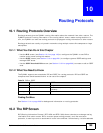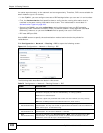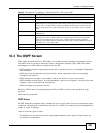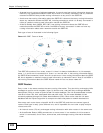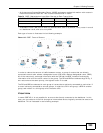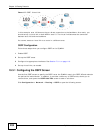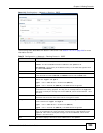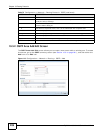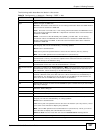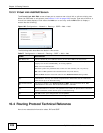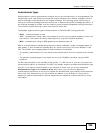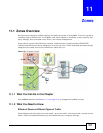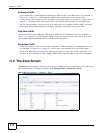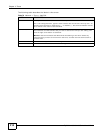
Chapter 10 Routing Protocols
ZyWALL 110/310/1100 Series User’s Guide
207
The following table describes the labels in this screen.
Table 76 Configuration > Network > Routing > OSPF > Add
LABEL DESCRIPTION
Area ID Type the unique, 32-bit identifier for the area in IP address format.
Type Select the type of OSPF area.
Normal - This area is a normal area. It has routing information about the OSPF AS and
about networks outside the OSPF AS.
Stub - This area is an stub area. It has routing information about the OSPF AS but not
about networks outside the OSPF AS. It depends on a default route to send information
outside the OSPF AS.
NSSA - This area is a Not So Stubby Area (NSSA), per RFC 1587. It has routing
information about the OSPF AS and networks that are outside the OSPF AS and are
directly connected to the NSSA. It does not have information about other networks
outside the OSPF AS.
Authentication Select the default authentication method used in the area. This authentication protects
the integrity, but not the confidentiality, of routing updates.
None uses no authentication.
Text uses a plain text password that is sent over the network (not very secure).
MD5 uses an MD5 password and authentication ID (most secure).
Text Authentication
Key
This field is available if the Authentication is Text. Type the password for text
authentication. The key can consist of alphanumeric characters and the underscore,
and it can be up to 16 characters long.
MD5 Authentication
ID
This field is available if the Authentication is MD5. Type the default ID for MD5
authentication in the area. The ID can be between 1 and 255.
MD5 Authentication
Key
This field is available if the Authentication is MD5. Type the default password for MD5
authentication in the area. The password can consist of alphanumeric characters and
the underscore, and it can be up to 16 characters long.
Virtual Link This section is displayed if the Type is Normal. Create a virtual link if you want to
connect a different area (that does not have a direct connection to the backbone) to
the backbone. You should set up the virtual link on the ABR that is connected to the
other area and on the ABR that is connected to the backbone.
Add Click this to create a new virtual link.
Edit Double-click an entry or select it and click Edit to open a screen where you can modify
the entry’s settings.
Remove To remove an entry, select it and click Remove. The ZyWALL confirms you want to
remove it before doing so.
# This field is a sequential value, and it is not associated with a specific area.
Peer Router ID This is the 32-bit ID (in IP address format) of the other ABR in the virtual link.
Authentication This is the authentication method the virtual link uses. This authentication protects the
integrity, but not the confidentiality, of routing updates.
None uses no authentication.
Text uses a plain text password that is sent over the network (not very secure). Hover
your cursor over this label to display the password.
MD5 uses an MD5 password and authentication ID (most secure). Hover your cursor
over this label to display the authentication ID and key.
Same as Area has the virtual link also use the Authentication settings above.
OK Click OK to save your changes back to the ZyWALL.
Cancel Click Cancel to exit this screen without saving.



